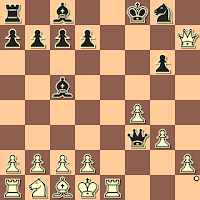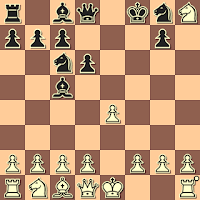Applying the Jerome Gambit strategy to an opening gives White wild attacking chances, at the risk of blowback if play stalls. An attacker who is comfortable in such complex situations is more likely to be successful.
The following game turns chaotic, and it is only after the first player overlooks a forced checkmate that the second one is able find mate himself.
Surikov, Ilsur - Papizzhe, Mikola
internet, 2015
1.e4 e5 2.Nf3 Nc6 3.Bc4 Nd4
The Blackburne Shilling Gambit.
4.Bxf7+
Blackburne Shilling Jerome Gambit.
Over the years, I have enjoyed the BSJG and have actually scored 90% in 46 games.
That said, White now has several playable alternatives, including 4.Nxd4, 4.c3, 4.d3, and 4.0-0. Black is hoping for chances after 4.Nxe5 Qg5.
4...Kxf7 5.Nxe5+ Ke6
6.f4
Protecting the Knight and introducing a pawn into the mix. This move appears in 498 games in The Database, with White scoring 49%.
More main line is 6.c3.
6...Qh4+
This is the problem with 6.f4 - it allows Black's Queen to invade White's Kingside. For the record, 6...Qh4+ only appears in 28% of those 6.f4 games in The Database.
7.g3 Qh3
8.c3
Instead, White can get rid of the pesky Knight and cover the g2 square with 8.Nf3 Nxf3+ 9.Qxf3. That would leave Black with an extra piece against White's extra two pawns.
8...Nc6
This is a calm, but incorrect, withdrawal.
Stockfish 14.1 prefers 8...Qg2 9.Rf1 d6 10.f5+ Ke7 11.cxd4 Qxe4+ 12.Qe2 Qxe2+ 13.Kxe2 dxe5 14.dxe5.
9.Nf3
The thing is, instead White has a checkmate: 9.Qb3+ d5 10.Qxd5+ Ke7 11.Qf7+ Kd6 12.Nc4+ Kc5 13.Qd5#.
9...h6 10.d4 Kf7
The broad pawn center puts the game in balance.
11.d5 Nd8 12.Ne5+ Ke8 13.Qb3
White would have done well to try 13.Qf3, keeping the enemy Queen out of g2, or 13.Nd2 followed by 14.Ndf3 to work on his development.
13...d6 14.Ng6
Abandoning his King for some treasure.
14...Ne7
Momentarily setting aside his plans on infiltrating the enemy Kingside.
15.Nxh8 Qg2
16.Rf1 Qxe4+ 17.Kd1
This brings an end to the game. Instead, 17.Kf2 Qh7 18.f5 Qxh8 19.Kg1 Kf7 20.g4 Kg8 reaches a somehow reasonable position that Stockfish 14.1 says is still better for Black.
17...Bg4+ 18.Kd2 Qe2 checkmate







































